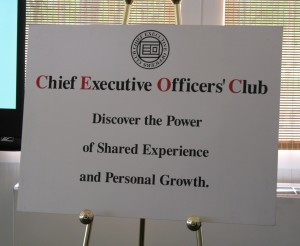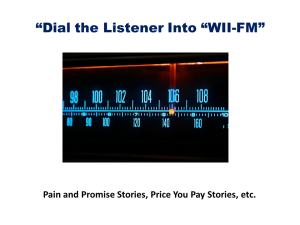How to Use a Pain and Promise Story to Tune Your Audience Into WII-FM
 If you want to grab your audience’s attention and capture their interest, don’t do a long drawn out intro stating obvious facts about the topic you are going to speak on.
If you want to grab your audience’s attention and capture their interest, don’t do a long drawn out intro stating obvious facts about the topic you are going to speak on.
Don’t give a long description of your background.
Instead, try starting out with a Pain and Promise Story, a story that captures the pain your audience feels about a problem you can solve and then illustrates “the Promise”–a vision of what will happen if they listen to, and apply, what you are going to share with them.
This helps them dial into that all important radio station–WII-FM–“What’s in it for me?”
 This video clip is of my opening story for a presentation I did called “Fascinating Inspiring U” for the CEO Club of Boston, whose membership consists of–surprisingly enough–CEOs, but also owners of professional service and financial services firms.
This video clip is of my opening story for a presentation I did called “Fascinating Inspiring U” for the CEO Club of Boston, whose membership consists of–surprisingly enough–CEOs, but also owners of professional service and financial services firms.
I chose this story to start off with because I knew the CEOs in the group would relate to the pain of trying to get buy-in from employees on something that to them is obvious, but ends up not being so obvious to employees…and how frustrating that is.
While I typically like to use stories from my own experience and own work, I often use this story from the folks at VitalSmarts, because it is so perfect. It comes from their book Influencer.
 For the owners of professional and financial service firms, I knew that while they would be able to relate to that frustration, probably more frustrating for them would be when potential clients don’t understand the value of the service they provide. So for them, the area where they want to be more persuasive is more in the sales and marketing arena.
For the owners of professional and financial service firms, I knew that while they would be able to relate to that frustration, probably more frustrating for them would be when potential clients don’t understand the value of the service they provide. So for them, the area where they want to be more persuasive is more in the sales and marketing arena.
I wanted to make sure the professional service and financial service firm owners would dial into that WII-FM, but the story didn’t include that context. I could have mentioned that context while telling the story (if you want to see an example of how to make that transition, see the commentary below the video).
However, in the interest of getting them actively involved as quickly as possible, I broke them up into pairs early on in the story to give them the chance to connect with their individual sources of pain.
The more you connect your audience with their pain from the outset, the more they will care about what you have to say.
The Pain and Promise Story is a great way to do that.
NOTE:
If you know your audience has multiple contexts where they are feeling pain, you can mention those as part of your story. So, if I had chosen not to break them into pairs during the story, I would have said something like this after getting to the part where the leaders’ message had the opposite effect of what they intended:
“I’m sure everyone in here can relate to that unpleasant experience. For others…the place where you feel the most frustrated around others not being persuaded by your message might be when talking to potential clients…and when you’re trying to show them how your service could help them…and they just aren’t getting it…or maybe its situations with colleagues or partners in your firm where you would want to be more persuasive…”
This is a language pattern I learned from my hypnosis training. You offer a variety of possible connections the person can make, to help them connect with your message.
